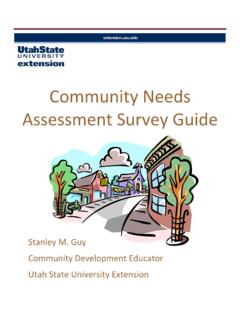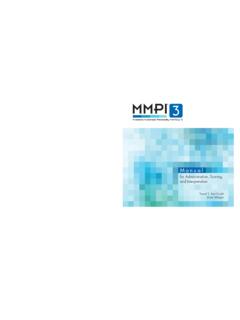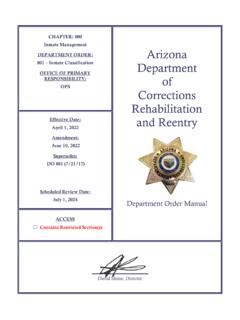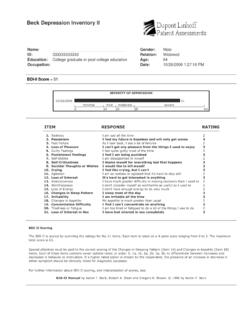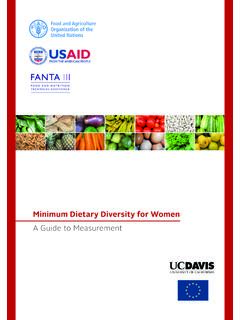Transcription of Alabama Parenting Questionnaire - CYFAR
1 Alabama Parenting Questionnaire Instrument: Alabama Parenting Questionnaire (APQ) Scale/Subscale Name: Alabama Parenting Questionnaire (APQ) Developers: Frick, P. J. Year: 1991 Target Audience(s): Parents of children 6-18 and children 6-18 Language other than English available: Chinese, Dutch, German, Spanish, Norwegian Type: Behavior Data collected: Quantitative Data collection format: Self report Pre/post Reading Level: Unavailable Existence of test/technical manuals, user guides, supplemental materials: Surveys and publications available at: Includes survey items and information on the psychometrics of the survey. Additional publications may be found at Level of training necessary for administration/ scoring /interpretation: None necessary. Paper and pencil scoring with the sum of ratings used as a total scale score. Widespread Use/Professional Endorsements: Scale has been used in multiple research articles looking at Parenting behaviors.
2 The University of New Orleans provides the tests and measures at: Credit must be given to the developers. Cost of Use: No cost associated with the survey. Dr. Frick requests that copies of any publications using the APQ are sent to him at Description: The APQ measures five dimensions of Parenting that are relevant to the etiology and treatment of child externalizing problems: (1) positive involvement with children, (2) supervision and monitoring, (3) use of positive discipline techniques, (4) consistency in the use of such discipline and (5) use of corporal punishment. There is both a parent form and a child form. 42 items Psychometrics: Information on reliability and validity are provided below. If information on a particular psychometric was not found, it is indicated as no information provided. It should be noted that this is not necessarily an indication of a lack of reliability or validity within a particular scale/instrument, but rather a lack of rigorous testing, for various reasons, by the developers or other researchers.
3 Reliability: A correlation of at least .80 is suggested for at least one type of reliability as evidence; however, standards range from .5 to .9 depending on the intended use and context for the instrument. Internal Consistency: The average reliability across the APQ scales is .68. Inter-rater reliability: No information provided Test-Retest: No information provided Validity: The extent to which a measure captures what it is intended to measure. Content/Face Validity: No information provided Criterion Validity: The APQ has good psychometric properties including criterion validity in differentiating clinical and nonclinical groups (Dadds, Maujean, & Fraser, 2003; Frick, Christian, &Wooton, 1999; Shelton et al., 1996). Frick et al. (1999) reported a mean r2 across its five scales of for predicting child symptoms of ODD and CD. Independent investigations have also shown the APQ to be an informative assessment tool. Construct Validity: No information provided Construct: Effective Parenting Scale Name: Alabama Parenting Questionnaire (APQ) Developers: Frick, P.
4 J. scoring for Parent Form: The items on the adult form are categorized into five subscales as follows: o Involvement: 1, 4, 7, 9, 11, 14, 15, 20, 23, 26 o Positive Parenting : 2, 5, 13, 16, 18, 27 o Poor Monitoring/Supervision: 6, 10, 17, 19, 21, 24, 28, 29, 30, 32 o Inconsistent Discipline: 3, 8, 12, 22, 25, 31 o Corporal Punishment: 33, 35, 39 No reverse coding necessesary. Sum all items in the scale to obtain a total scale score (you may subtract this score by the number of items in the subscale so that the score range begins at zero). Other Discipline Practices is not a scale, but provides information on an item by item basis. Numbers for these items are: 34, 36, 37, 39, 40, 41, 42 scoring for Child Form: The items on the child form are categorized into five subscales that are reflective of the parent subscales: o Involvement: 1, 4, 7, 9, 11, 14, 15, 20, 23, 26 (there are two parts to each of these questions one for mother involvement and one for father involvement) o Positive Parenting : 2, 5, 13, 16, 18, 27 o Poor Monitoring/Supervision: 6, 10, 17, 19, 21, 24, 28, 29, 30, 32 o Inconsistent Discipline: 3, 8, 12, 22, 25, 31 o Corporal Punishment: 33, 35, 39 No reverse coding necessesary.
5 Sum all items in the scale to obtain a total scale score (you may subtract this score by the number of items in the subscale so that the score range begins at zero). Other Discipline Practices is not a scale, but provides information on an item by item basis. Numbers for these items are: 34, 36, 37, 39, 40, 41, 42


